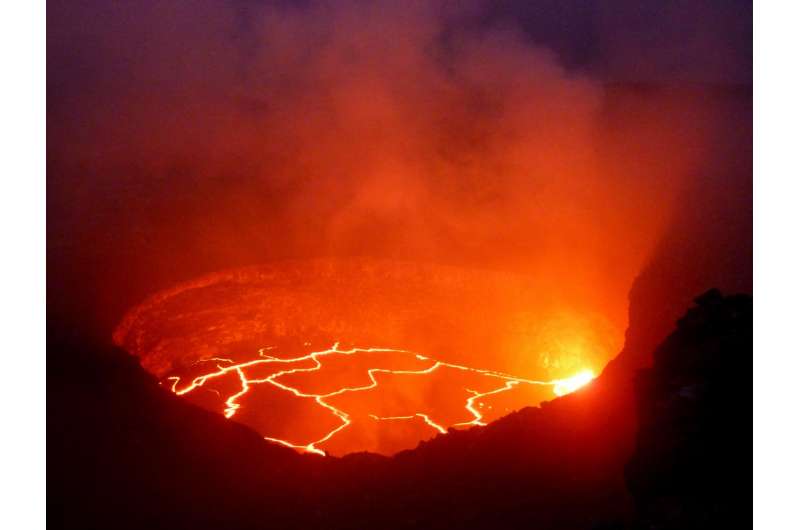'Bulges' in volcanoes could be used to predict eruptions

A team of researchers from the University of Cambridge have developed a new way of measuring the pressure inside volcanoes, and found that it can be a reliable indicator of future eruptions.
Using a technique called 'seismic noise interferometry' combined with geophysical measurements, the researchers measured the energy moving through a volcano. They found that there is a good correlation between the speed at which the energy travelled and the amount of bulging and shrinking observed in the rock. The technique could be used to predict more accurately when a volcano will erupt. Their results are reported in the journal Science Advances.
Data was collected by the US Geological Survey across K?lauea in Hawaii, a very active volcano with a lake of bubbling lava just beneath its summit. During a four-year period, the researchers used sensors to measure relative changes in the velocity of seismic waves moving through the volcano over time. They then compared their results with a second set of data which measured tiny changes in the angle of the volcano over the same time period.
As K?lauea is such an active volcano, it is constantly bulging and shrinking as pressure in the magma chamber beneath the summit increases and decreases. K?lauea's current eruption started in 1983, and it spews and sputters lava almost constantly. Earlier this year, a large part of the volcano fell away and it opened up a huge 'waterfall' of lava into the ocean below. Due to this high volume of activity, K?lauea is also one of the most-studied volcanoes on Earth.
The Cambridge researchers used seismic noise to detect what was controlling K?lauea's movement. Seismic noise is a persistent low-level vibration in the Earth, caused by everything from earthquakes to waves in the ocean, and can often be read on a single sensor as random noise. But by pairing sensors together, the researchers were able to observe energy passing between the two, therefore allowing them to isolate the seismic noise that was coming from the volcano.
"We were interested in how the energy travelling between the sensors changes, whether it's getting faster or slower," said Clare Donaldson, a PhD student in Cambridge's Department of Earth Sciences, and the paper's first author. "We want to know whether the seismic velocity changes reflect increasing pressure in the volcano, as volcanoes bulge out before an eruption. This is crucial for eruption forecasting."
One to two kilometres below K?lauea's lava lake, there is a reservoir of magma. As the amount of magma changes in this underground reservoir, the whole summit of the volcano bulges and shrinks. At the same time, the seismic velocity changes. As the magma chamber fills up, it causes an increase in pressure, which leads to cracks closing in the surrounding rock and producing faster seismic waves - and vice versa.
"This is the first time that we've been able to compare seismic noise with deformation over such a long period, and the strong correlation between the two shows that this could be a new way of predicting volcanic eruptions," said Donaldson.
Volcano seismology has traditionally measured small earthquakes at volcanoes. When magma moves underground, it often sets off tiny earthquakes, as it cracks its way through solid rock. Detecting these earthquakes is therefore very useful for eruption prediction. But sometimes magma can flow silently, through pre-existing pathways, and no earthquakes may occur. This new technique will still detect the changes caused by the magma flow.
Seismic noise occurs continuously, and is sensitive to changes that would otherwise have been missed. The researchers anticipate that this new research will allow the method to be used at the hundreds of active volcanoes around the world.
More information: "Relative seismic velocity variations correlate with deformation at Kīlauea volcano" Science Advances (2017). DOI: 10.1126/sciadv.1700219 , advances.sciencemag.org/content/3/6/e1700219
Journal information: Science Advances
Provided by University of Cambridge




















